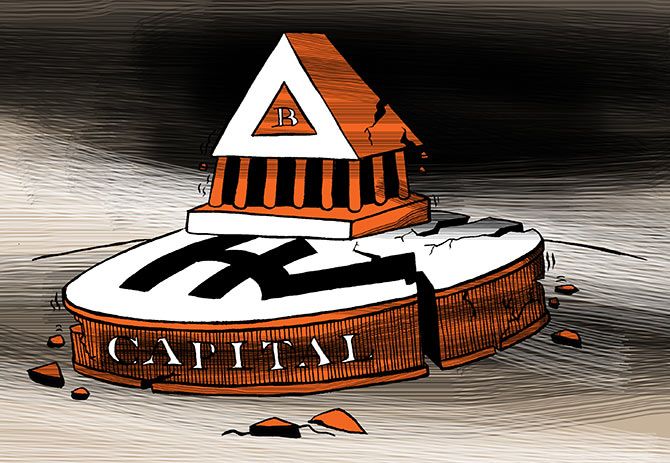 | « Back to article | Print this article |
Given the various risks to growth, one could argue for rate cuts to be deeper than the 5 per cent terminal repo rate that we are projecting at this stage, says Kaushik Das.
Illustration: Uttam Ghosh/Rediff.com

We are not surprised by the Reserve Bank of India’s (RBI’s) decision to cut the repo rate by 35 basis points (bps).
In fact, we wrote about this possibility in a recent report.
We think the monetary policy committee will cut repo rate by another 40 bps in the rest of 2019-20 (FY20).
After having delivered four back-to-back rate cuts, we expect the RBI to pause in the October 4 policy (or just deliver a 15-bps rate cut), but we see the central bank delivering a 25-bps rate cut in the December policy, once the July-September gross domestic product (GDP) data is out in end-November.
If the RBI maintains status quo in the October policy and delivers a 25-bps rate cut in December, then we expect the next rate cut to be 15 bps (either in February or April), driving the repo rate down to 5 per cent.
Further rate cuts are contingent on the non-banking financial company (NBFC) sector recovery prospect.
If the NBFC sector problem worsens in the next few months, we do not rule out the possibility of further rate cuts in 2020-21 to put a downside floor to growth risks, but if the NBFC sector stabilises, we don’t expect the RBI to cut the repo rate below 5 per cent in such a scenario.
The RBI has revised its GDP growth projection to 6.9 per cent (from 7 per cent earlier) for FY20, but there could be more downside risks if the NBFC sector problems linger on and the 2019 monsoon turns out to be negative.
However, we think India’s potential growth rate is in the range of 7 per cent and 7.5 per cent, and if the RBI’s projection for the second half of FY20 growth is correct (7.3-7.5 per cent), then additional rate cuts beyond the 5 per cent repo rate may not be necessary.
The RBI’s latest inflation projection is broadly realistic, though slightly lower than our forecasts.
We are forecasting consumer price index-based inflation to average 3.5 per cent in FY20.
Assuming the RBI wants to maintain 1.5 per cent positive real rates, repo rate can potentially come down to 5 per cent.
We expect the RBI to maintain surplus liquidity in the banking system (at least 1 per cent of net demand and time liabilities on average), as that is a precondition for monetary transmission to take place in the economy.
Monetary transmission has been weak and delayed so far. But with 110-bps rate cut already delivered by the RBI, liquidity having turned surplus, and more rate cuts likely in the period ahead, monetary transmission is likely to gain traction from hereupon.
Given the various risks to growth, one could argue for rate cuts to be deeper than the 5 per cent terminal repo rate that we are projecting at this stage.
It is not that space is not available for further rate cuts beyond 5 per cent, but it is prudent in our view to maintain a certain amount of buffer, in case the factors supporting the rate-easing cycle (particularly the global factors) were to reverse quickly.
Preserving some buffer will help the RBI to hold interest rates lower for a longer time, which will be more beneficial for the economy, rather than cutting very deep now and having to reverse course as soon as the economic conditions start improving.
Kaushik Das is the India economist of Deutsche Bank AG.Views expressed are personal.